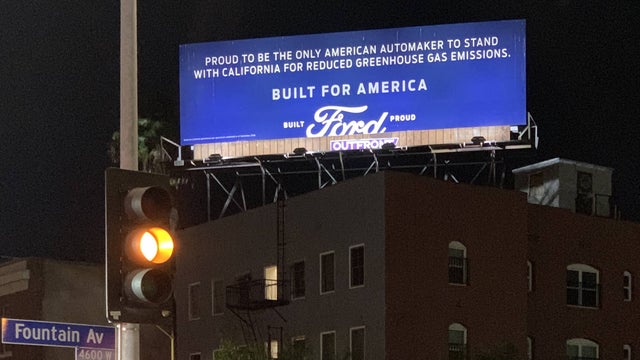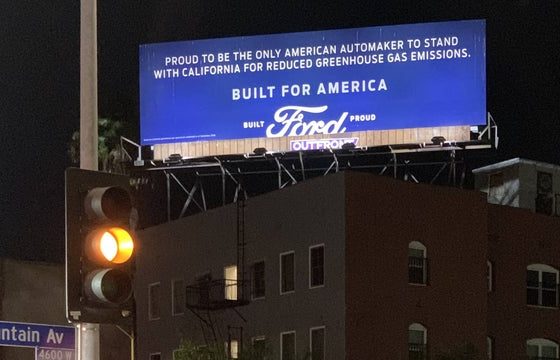

News
Tesla’s existence once again ignored by Ford in support of CA emissions regulations
Ford’s EV initiative has barely gotten off of the ground, but it still hasn’t stopped the American automaker from casting stones in the direction of Tesla. A billboard posting in Hollywood, California from Ford implies that it is the only American car company to support the State’s strict emissions regulations, which is simply untrue. Tesla is perhaps the biggest supporter, considering their entire vehicle lineup is all-electric, but Ford is unwilling to acknowledge the EV leader’s role in the transition to electrification.
The billboard is available near Fountain Avenue, which runs from Los Feliz all the way to West Hollywood. While virtually all areas of Los Angeles are considered “high traffic,” this billboard’s location runs through the heart of the city’s touristy-region in Hollywood. A photograph of the sign was spotted and posted to the Tesla Motors Club forum by user feigen66. It reads, “Proud to be the only American Automaker to stand with California for reduced greenhouse gas emissions,” with a sizeable Ford logo placed underneath the caption.
Tesla Motors Club | feigen66
Ford’s self-recognition as the sole American automaker to stand with California’s greenhouse gas standards is a case of the company ignoring Tesla’s dominating presence in the Golden State. Humorously, Tesla is based in the state where Ford’s satirical billboard is placed, making the statement more comedic than it is at face value.
The fact is, Ford is not the only American car company to support California’s emissions regulations. Tesla has been benefitting from supporting the State’s environmental plan for over a year. Last November, California announced that it would no longer purchase cars from General Motors, Toyota, or Fiat Chrysler because the companies did not agree to abide by the state’s rules regarding vehicle emissions.
Instead, companies that openly supported California’s greenhouse emissions policies would receive the State’s support. This would open the door for companies like Tesla to have their vehicles purchased by the State, but Ford is still suggesting that it is the only car company to side with California.
But to many people’s surprise, this is not the first time Ford has given Tesla the cold shoulder. The American company, based in Dearborn, Michigan, made the same statement in September 2020. Jim Farley, Ford’s current CEO, Tweeted the same message just two months ago, failing to acknowledge Tesla’s existence in an attempt to win over the politicians of California.
Ford seemingly denies Tesla’s existence as it supports CA’s zero-emissions initiative
While supportive of the transition to EVs, Ford still has not released a fully-electric car as of now. However, the company’s Mustang Mach-E will be released before the end of the year, introducing the public to the first all-electric car in Ford’s storied history as a carmaker. With that being said, the company’s non-acknowledgment of Tesla is questionable. With Tesla being the undisputed leader in electric vehicle production, credit should be given where it is due.
While car companies are undoubtedly competing with one another to sell the most vehicles, adopting all-electric vehicles is somewhat of a team effort. Tesla should receive the recognition it deserves for bringing top-performing EVs to the market and also highlighting the importance of transitioning away from petrol-powered engines.
H/t: @heydave7 on Twitter

News
Tesla starts showing how FSD will change lives in Europe
Local officials tested the system on narrow country roads and were impressed by FSD’s smooth, human-like driving, with some calling the service a game-changer for everyday life in areas that are far from urban centers.

Tesla has launched Europe’s first public shuttle service using Full Self-Driving (Supervised) in the rural Eifelkreis Bitburg-Prüm region of Germany, demonstrating how the technology can restore independence and mobility for people who struggle with limited transport options.
Local officials tested the system on narrow country roads and were impressed by FSD’s smooth, human-like driving, with some calling the service a game-changer for everyday life in areas that are far from urban centers.
Officials see real impact on rural residents
Arzfeld Mayor Johannes Kuhl and District Administrator Andreas Kruppert personally tested the Tesla shuttle service. This allowed them to see just how well FSD navigated winding lanes and rural roads confidently. Kruppert said, “Autonomous driving sounds like science fiction to many, but we simply see here that it works totally well in rural regions too.” Kuhl, for his part, also noted that FSD “feels like a very experienced driver.”
The pilot complements the area’s “Citizen Bus” program, which provides on-demand rides for elderly residents who can no longer drive themselves. Tesla Europe shared a video of a demonstration of the service, highlighting how FSD gives people their freedom back, even in places where public transport is not as prevalent.
What the Ministry for Economic Affairs and Transport says
Rhineland-Palatinate’s Minister Daniela Schmitt supported the project, praising the collaboration that made this “first of its kind in Europe” possible. As per the ministry, the rural rollout for the service shows FSD’s potential beyond major cities, and it delivers tangible benefits like grocery runs, doctor visits, and social connections for isolated residents.
“Reliable and flexible mobility is especially vital in rural areas. With the launch of a shuttle service using self-driving vehicles (FSD supervised) by Tesla in the Eifelkreis Bitburg-Prüm, an innovative pilot project is now getting underway that complements local community bus services. It is the first project of its kind in Europe.
“The result is a real gain for rural mobility: greater accessibility, more flexibility and tangible benefits for everyday life. A strong signal for innovation, cooperation and future-oriented mobility beyond urban centers,” the ministry wrote in a LinkedIn post.
News
Tesla China quietly posts Robotaxi-related job listing
Tesla China is currently seeking a Low Voltage Electrical Engineer to work on circuit board design for the company’s autonomous vehicles.

Tesla has posted a new job listing in Shanghai explicitly tied to its Robotaxi program, fueling speculation that the company is preparing to launch its dedicated autonomous ride-hailing service in China.
As noted in the listing, Tesla China is currently seeking a Low Voltage Electrical Engineer to work on circuit board design for the company’s autonomous vehicles.
Robotaxi-specific role
The listing, which was shared on social media platform X by industry watcher @tslaming, suggested that Tesla China is looking to fill the role urgently. The job listing itself specifically mentions that the person hired for the role will be working on the Low Voltage Hardware team, which would design the circuit boards that would serve as the nervous system of the Robotaxi.
Key tasks for the role, as indicated in the job listing, include collaboration with PCB layout, firmware, mechanical, program management, and validation teams, among other responsibilities. The role is based in Shanghai.
China Robotaxi launch
China represents a massive potential market for robotaxis, with its dense urban centers and supportive policies in select cities. Tesla has limited permission to roll out FSD in the country, though despite this, its vehicles have been hailed as among the best in the market when it comes to autonomous features. So far, at least, it appears that China supports Tesla’s FSD and Robotaxi rollout.
This was hinted at in November, when Tesla brought the Cybercab to the 8th China International Import Expo (CIIE) in Shanghai, marking the first time that the autonomous two-seater was brought to the Asia-Pacific region. The vehicle, despite not having a release date in China, received a significant amount of interest among the event’s attendees.
Elon Musk
Elon Musk and Tesla AI Director share insights after empty driver seat Robotaxi rides
The executives’ unoccupied tests hint at the rapid progress of Tesla’s unsupervised Robotaxi efforts.

Tesla CEO Elon Musk and AI Director Ashok Elluswamy celebrated Christmas Eve by sharing personal experiences with Robotaxi vehicles that had no safety monitor or occupant in the driver’s seat. Musk described the system’s “perfect driving” around Austin, while Elluswamy posted video from the back seat, calling it “an amazing experience.”
The executives’ unoccupied tests hint at the rapid progress of Tesla’s unsupervised Robotaxi efforts.
Elon and Ashok’s firsthand Robotaxi insights
Prior to Musk and the Tesla AI Director’s posts, sightings of unmanned Teslas navigating public roads were widely shared on social media. One such vehicle was spotted in Austin, Texas, which Elon Musk acknowleged by stating that “Testing is underway with no occupants in the car.”
Based on his Christmas Eve post, Musk seemed to have tested an unmanned Tesla himself. “A Tesla with no safety monitor in the car and me sitting in the passenger seat took me all around Austin on Sunday with perfect driving,” Musk wrote in his post.
Elluswamy responded with a 2-minute video showing himself in the rear of an unmanned Tesla. The video featured the vehicle’s empty front seats, as well as its smooth handling through real-world traffic. He captioned his video with the words, “It’s an amazing experience!”
Towards Unsupervised operations
During an xAI Hackathon earlier this month, Elon Musk mentioned that Tesla owed be removing Safety Monitors from its Robotaxis in Austin in just three weeks. “Unsupervised is pretty much solved at this point. So there will be Tesla Robotaxis operating in Austin with no one in them. Not even anyone in the passenger seat in about three weeks,” he said. Musk echoed similar estimates at the 2025 Annual Shareholder Meeting and the Q3 2025 earnings call.
Considering the insights that were posted Musk and Elluswamy, it does appear that Tesla is working hard towards operating its Robotaxis with no safety monitors. This is quite impressive considering that the service was launched just earlier this year.








